Kenya Kids Can is partnering with the local community to provide a simple hot lunch of maize and beans to primary school children. Locally this meal is known as githeri and it is a staple of the Kenyan diet.
A True Partnership
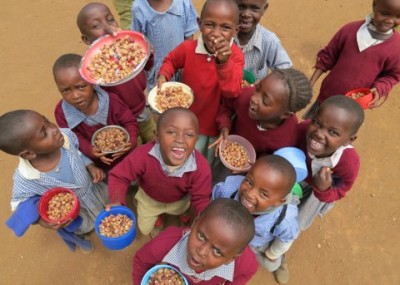 One of the exciting aspects of this program is that it’s a true partnership. When the feeding program comes to a school, the community joins together to build a kitchen, buy the pots, and hire a cook. The school also provides a storeroom for the maize and beans, secures fuel and water for cooking, and provides all of the on-site labor needed to serve daily school lunches. Kenya Kids Can participates by purchasing and delivering maize, beans, and cooking fat to the schools. Even the children play a role: they provide their own bowl, and in our rural schools they bring a stick to school each day to fuel the cooking fire.
One of the exciting aspects of this program is that it’s a true partnership. When the feeding program comes to a school, the community joins together to build a kitchen, buy the pots, and hire a cook. The school also provides a storeroom for the maize and beans, secures fuel and water for cooking, and provides all of the on-site labor needed to serve daily school lunches. Kenya Kids Can participates by purchasing and delivering maize, beans, and cooking fat to the schools. Even the children play a role: they provide their own bowl, and in our rural schools they bring a stick to school each day to fuel the cooking fire.
Because everyone is helping in the ways that they can, the cost of the program is very low. Each hot meal served costs Kenya Kids Can only 10 cents.
Benefits of a School Lunch Program
A quick internet search on the “benefits of a school lunch program” will yield a significant body of work documenting the many ways that a school lunch improves school attendance, concentration, and behavior of the students. What’s remarkable is that this research comes primarily from the US, where the GDP per capita is over $70,000. Now imagine the benefits in Kenya, where the GDP per capita is less than $2,100.
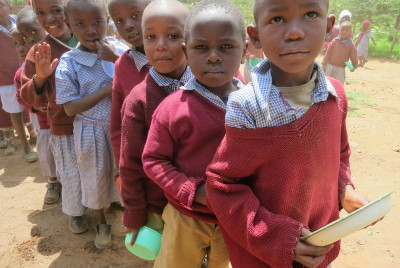 Many children walk long distances to go to school here…and there are no packed lunches. No brown paper bags or lunch boxes, no sliced bread, no sandwich meat, no grapes or numerous other items parents in the US put in their children’s lunches. In the areas we serve, children would normally either bring chai for lunch (tea mixed with milk and sugar), or leave school at lunchtime to look for food, often not returning to school that day.
Many children walk long distances to go to school here…and there are no packed lunches. No brown paper bags or lunch boxes, no sliced bread, no sandwich meat, no grapes or numerous other items parents in the US put in their children’s lunches. In the areas we serve, children would normally either bring chai for lunch (tea mixed with milk and sugar), or leave school at lunchtime to look for food, often not returning to school that day.
When Kenya Kids Can and the local community team together to provide lunches for the children, the teachers comment that the children have enough energy to not only learn, but also run and play. In addition, absenteeism drops, grades go up, and the community becomes stronger.
FAQs About How the School Lunch Program Works
• How many schools and children are in the program?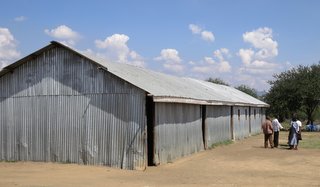
We currently have over 37 primary schools in our program, with about 21,000 children eating lunch each school day. There are “neighbor” schools we are currently not working with; we hope to be able to expand the program to include some of these. Here is a photo of the next school we hope to add to our program when funding allows.
• What are the kitchens like?
The “kitchens” vary significantly, ranging from an outdoor fire to a block building with a wood-fired cooker.
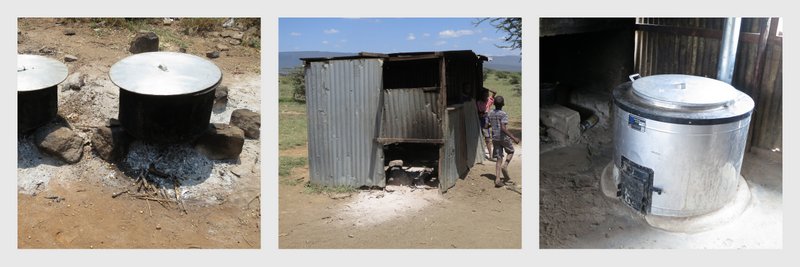
• I have heard many of the schools don’t have running water or electricity. How do they get water for cooking the food?
Securing water can be challenging for schools. Most schools take a multi-pronged approach. They often have tanks that collect water from roofs, which provide water if it has recently rained. Some schools have a pipe (from a shared water source) that leads to a single tap in the schoolyard. Sometimes there is water at the tap; sometimes there isn’t. If the water tank and the tap are both dry, then they purchase barrels of water, delivered by donkey cart.
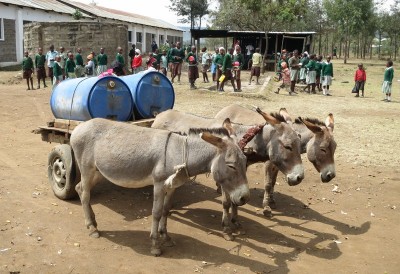
Water being delivered to one of our schools. Notice back left is a block tank that is broken and back right is the kitchen.
• Where does the school get wood to cook the food?
How fuel is obtained for the fires depends on the surrounding environment. For some schools, the children arrive each day with a stick. The amassed pile of wood is usually sufficient for the fires. In other schools, bringing sticks is not an option and fuel is instead purchased by donkey cart. This can be a significant expense for a school, so schools that have not yet obtained a wood-burning cooker are usually actively seeking one. Once a school has a cooker, the fuel consumption goes down by a factor of five.
Learn more about how you can help feed kids in the Rift Valley.

